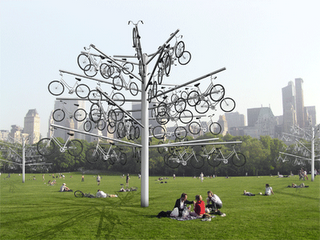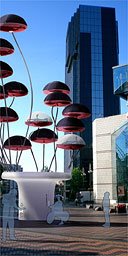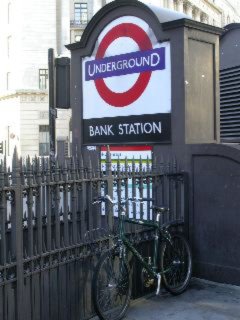Design, crime, and cycling in the city
Reinventing the bike shed
 Bikes are booming in London. It isn't all that surprising since European cities in general are well-known for encouraging people powered transportation. London has experienced a 50% increase in bike commuting over the last five years. And in Amsterdam, 27% of all trips are made by bike.
Bikes are booming in London. It isn't all that surprising since European cities in general are well-known for encouraging people powered transportation. London has experienced a 50% increase in bike commuting over the last five years. And in Amsterdam, 27% of all trips are made by bike. Like London, European cities also lead the world in imaginative, aesthetically significant design. I first realized this during a trip to Dublin back in 2001. There I met Lynne, a street artist whose paintings blend stark expressionism with a customary Gaelic whimsy.
Like London, European cities also lead the world in imaginative, aesthetically significant design. I first realized this during a trip to Dublin back in 2001. There I met Lynne, a street artist whose paintings blend stark expressionism with a customary Gaelic whimsy. Now, across the Irish Sea, the University of the Arts London has invited young designers to reinvent the bike shed. Bike shed? you ask. In the UK, this refers to everything from the familar backyard sheds to municipal schemes for secure bike parking.
Now, across the Irish Sea, the University of the Arts London has invited young designers to reinvent the bike shed. Bike shed? you ask. In the UK, this refers to everything from the familar backyard sheds to municipal schemes for secure bike parking. Two urban realities have inpsired the design competition. As biking has increased so have bike thefts. Despite this, municipal planners have been slow to come up with practical solutions. C. Northcote Parkinson first observed this problem in 1957. Referring to it as The Colour of the Bike Shed Effect, he explained that it's far easier to get nuclear power plants built than bike sheds. Why? Because local government officials who don't know that much about nuclear power plants typically won't question designs submitted experts. In contrast, the same officials think they know as much about bike sheds as the designers. So the whole planning process gets bogged down in debates over every aspect of the design, like the bike shed's color.
Two urban realities have inpsired the design competition. As biking has increased so have bike thefts. Despite this, municipal planners have been slow to come up with practical solutions. C. Northcote Parkinson first observed this problem in 1957. Referring to it as The Colour of the Bike Shed Effect, he explained that it's far easier to get nuclear power plants built than bike sheds. Why? Because local government officials who don't know that much about nuclear power plants typically won't question designs submitted experts. In contrast, the same officials think they know as much about bike sheds as the designers. So the whole planning process gets bogged down in debates over every aspect of the design, like the bike shed's color. The variety of bike shed submissions reflects the continuing influence of this effect. They include everything from the practical to the fantastic. Chun Yeug Cheng & Ka Fai Lee would plant Bike Trees throughout London's parks. Using a pulley system, bikers hoist their machines to safety. It's a visually stunning idea. Nevertheless, would they want them exposed to England's famously rainy weather?
The variety of bike shed submissions reflects the continuing influence of this effect. They include everything from the practical to the fantastic. Chun Yeug Cheng & Ka Fai Lee would plant Bike Trees throughout London's parks. Using a pulley system, bikers hoist their machines to safety. It's a visually stunning idea. Nevertheless, would they want them exposed to England's famously rainy weather? David Eburah also hoists bikes out of the reach of thieves. His design, The Placycle, employs helium inflated plastic pods tethered to the bike station. This most certainly would protect bikes from the elements. But how would Londoners react to the potentially meanacing sight of Martian-like machines lumbering over the urban landscape?
David Eburah also hoists bikes out of the reach of thieves. His design, The Placycle, employs helium inflated plastic pods tethered to the bike station. This most certainly would protect bikes from the elements. But how would Londoners react to the potentially meanacing sight of Martian-like machines lumbering over the urban landscape? In contrast, Claire Bandy's Bicycle Pod doesn't bring to mind the sci-fi terrors of War of the Worlds or The Invasion of the Body Snatchers. It puts bikes out of harm's way, from thieves and the weather alike, with a simple steel container. While practical and relatively cheap, this design isn't very visually inspiring. I just can't imagine central London littered with 100s of rusting hulks covered in corporate advertisements and splattered with graffiti.
In contrast, Claire Bandy's Bicycle Pod doesn't bring to mind the sci-fi terrors of War of the Worlds or The Invasion of the Body Snatchers. It puts bikes out of harm's way, from thieves and the weather alike, with a simple steel container. While practical and relatively cheap, this design isn't very visually inspiring. I just can't imagine central London littered with 100s of rusting hulks covered in corporate advertisements and splattered with graffiti. The competition's winners will be announced on 30 october. I hope they choose a design that is both practical and aesthetically pleasing. Basically, what bikers around the world need is a viable option to parking on the fly. The daily inconvenience of sodden saddles, rusty gears, and ingenious thieves is perhaps the biggest obstacle preventing bike commuting from becoming the norm of urban life rather than an eccentric irritant to both cagers and pedestrians.
The competition's winners will be announced on 30 october. I hope they choose a design that is both practical and aesthetically pleasing. Basically, what bikers around the world need is a viable option to parking on the fly. The daily inconvenience of sodden saddles, rusty gears, and ingenious thieves is perhaps the biggest obstacle preventing bike commuting from becoming the norm of urban life rather than an eccentric irritant to both cagers and pedestrians.Labels: cagers, new urbanism, rolling abroad, that which rolls







1 Comments:
European cities also lead the world in imaginative, aesthetically significant design. I first realized this during a trip to Dublin back in 2001.
Dublin is, sadly, not the most bike friendly of cities. Our bike lanes are terrible (when they exist) and traffic is not used to sharing the road.
Interesting blog, I'll be keeping an eye - cheers!
Al.
Post a Comment
<< Home